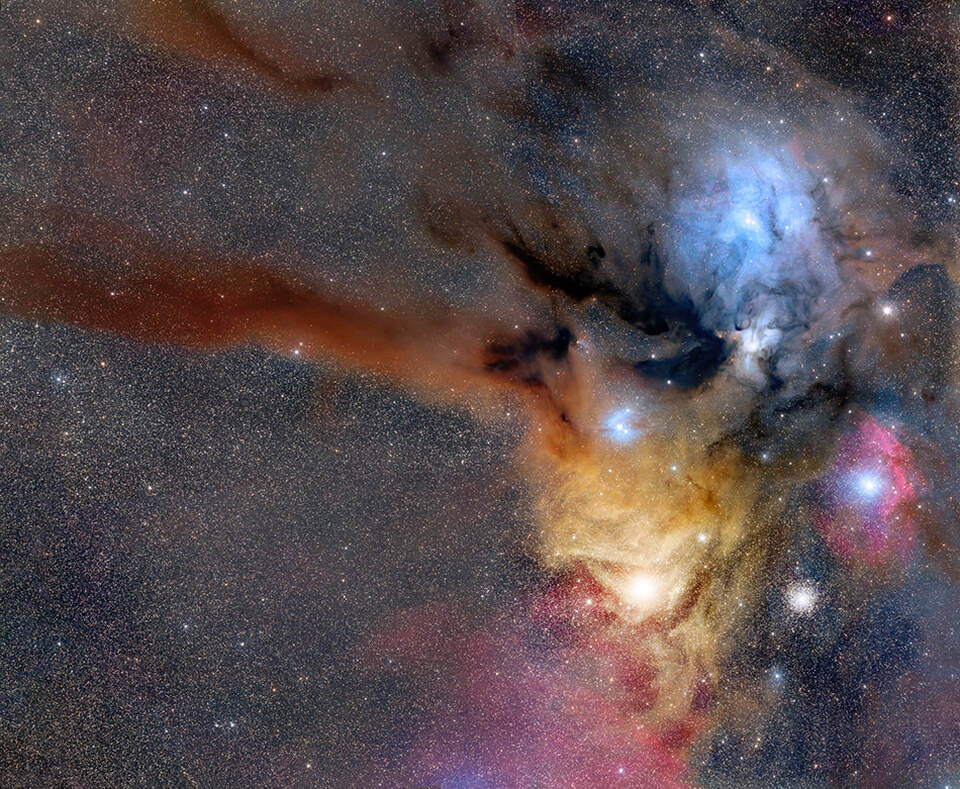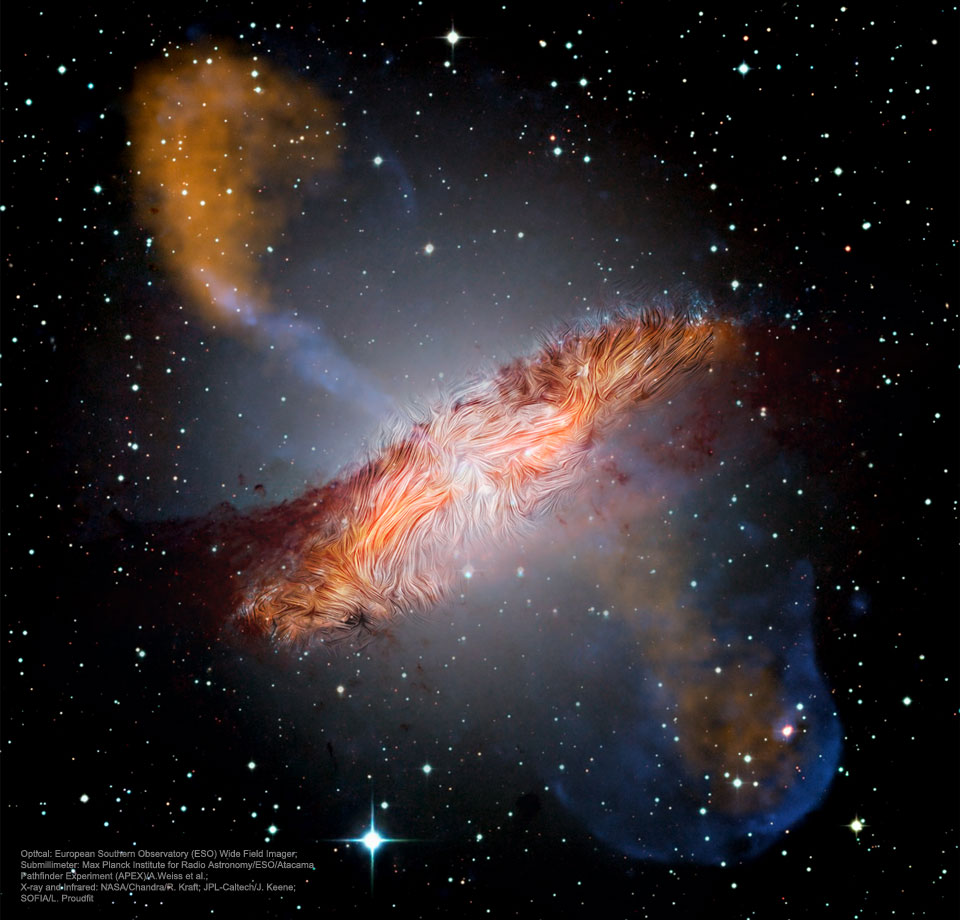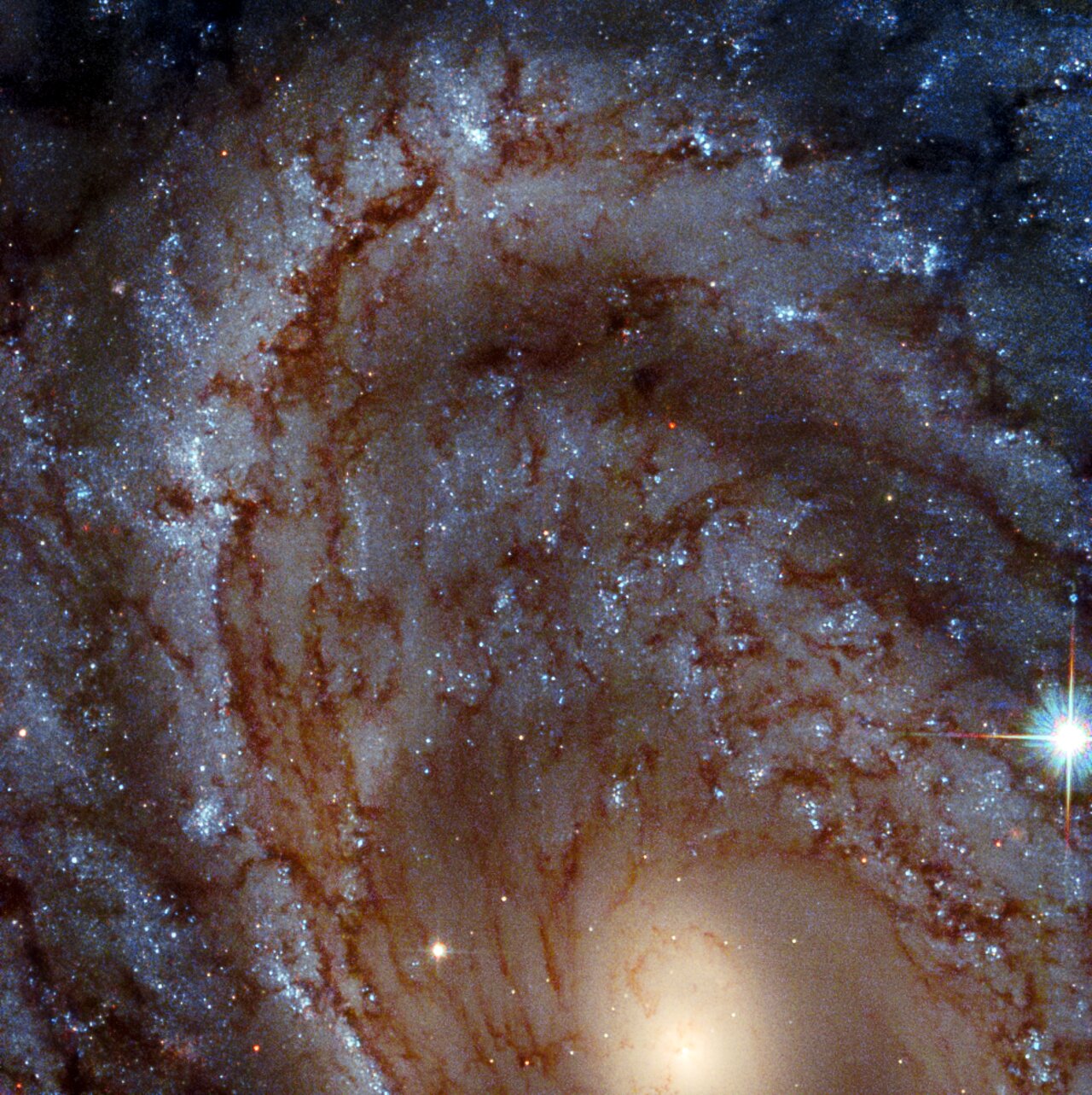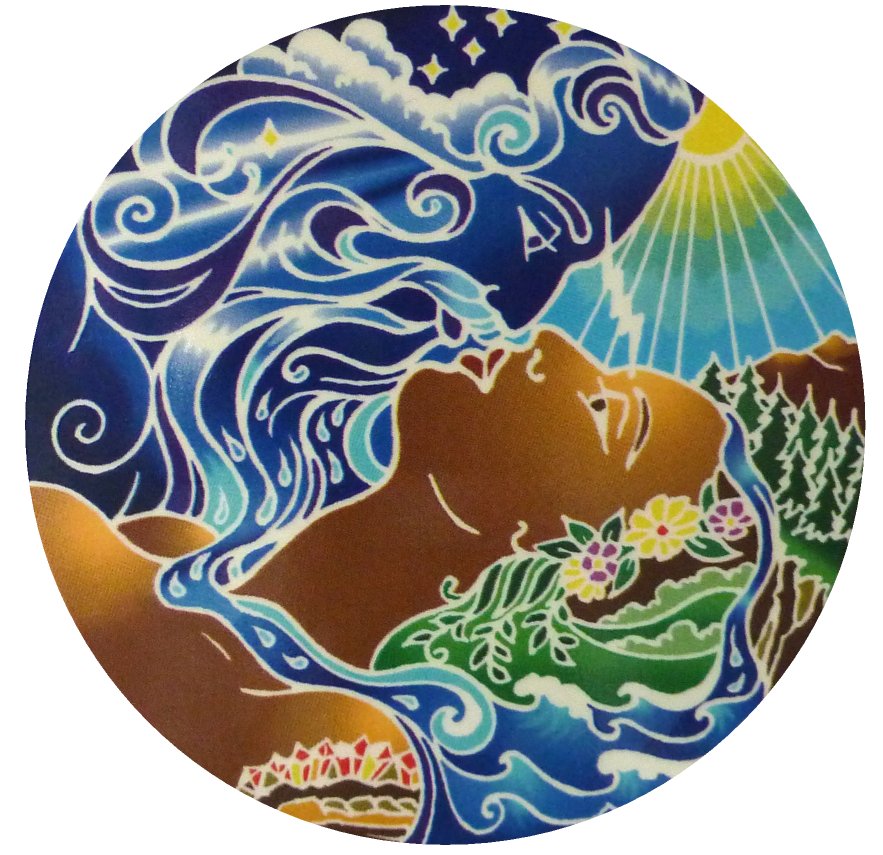Blog
Zapateado is a style of dance and traditional music of Andalusian origins in metre 6
8, with lively movement, marked on two beats, the second being very stressed. The dance shows a gracious tapping. Humanists of 16th century affirmed that zapateado derived from the lactisma of the Roman dancers in times of the Empire.
Among the composers who write Spanish Zapateados is Paco de Lucía, whose Percusión Flamenca is a very popular piece for guitar and orchestra. Pablo de Sarasate composed a Zapateado for violin and piano as part of his Spanish Dances, Op. 23. The piece is replete with harmonics, double stops, left hand pizzicatos, and is often performed by young virtuosos.
more...Rho Ophiuchi (ρ Ophiuchi) is a multiple star system in the constellation Ophiuchus. The central system has an apparent magnitude of 4.63. Based on the central system’s parallax of 9.03 mas, it is located about 360 light-years (110 parsecs) away. The other stars in the system are slightly farther away.
The central pair is known as Rho Ophiuchi AB. It consists of at least two blue-colored subgiants or main-sequence stars, designated Rho Ophiuchi A and B, respectively. Rho Ophiuchi AB is a visual binary, and the sky-projected distance between the two stars appears to be 3.1″, corresponding to a separation of at least 344 astronomical units (au).

Harvey William Mason (born February 22, 1947) is an American jazz drummer, record producer, and member of the band Fourplay. Mason grew up in Atlantic City, New Jersey and attended Atlantic City High School.
Mason endorses Canopus drums, Murat Diril cymbals, Remo drumheads, DW pedals, and Vic Firth drumsticks. Mason has his own Vic Firth Harvey Mason signature drumstick and Vic Firth Harvey Mason Chameleon signature drumstick.
https://www.youtube.com/watch?v=SvXxuyEU-0s
more...Paul Laurence Dunbar Chambers Jr. (April 22, 1935 – January 4, 1969) was a jazz double bassist. A fixture of rhythm sections during the 1950s and 1960s, his importance in the development of jazz bass can be measured not only by the extent of his work in this short period, but also by his impeccable timekeeping and virtuosic improvisations. He was also known for his bowed solos. Chambers recorded about a dozen albums as a leader or co-leader, and as a sideman, especially as the anchor of trumpeter Miles Davis‘s “first great quintet” (1955–63) and with pianist Wynton Kelly(1963–68).
Born in Pittsburgh, Pennsylvania on April 22, 1935, to Paul Lawrence Chambers and Margaret Echos. He was brought up in Detroit, Michigan following the death of his mother. He began playing music with several of his schoolmates on the baritone horn. Later he took up the tuba. “I got along pretty well, but it’s quite a job to carry it around in those long parades, and I didn’t like the instrument that much”.
more...
Joe Cuba (April 22, 1931 – February 15, 2009), was an American conga drummer of Puerto Rican descent widely regarded as the “Father of Latin Boogaloo“.
Cuba (birth name: Gilberto Miguel Calderón Cardona) was born in New York City, Cuba’s parents moved from Puerto Rico to New York City in the late 1920s and settled in Spanish Harlem, a Latino community located in Manhattan. Cuba was raised in an apartment building where his father had become the owner of a candy store located on the ground floor (street level floor). His father had organized a stickball club called the Young Devils. Stickball was the main sport activity of the neighborhood. After Cuba broke a leg he took up playing the conga and continued to practice with the conga between school and his free time. Eventually, he graduated from high school and joined a band.
In 1950, when he was 19 years old, he played for Joe Panama and also for a group called La Alfarona X. The group soon disbanded and Cuba enrolled in college to study law. While at college he attended a concert in which Tito Puente performed “Abaniquito“. He went up to Tito and introduced himself as a student and fan and soon they developed what was to become a lifetime friendship. This event motivated Cuba to organize his own band. In 1954, his agent recommended that he change the band’s name from the José Calderón Sextet to the Joe Cuba Sextet and the newly named Joe Cuba Sextet made their debut at the Stardust Ballroom.
more...Charles Mingus Jr. (April 22, 1922 – January 5, 1979) was an American jazz double bassist, pianist, composer and bandleader. A major proponent of collective improvisation, he is considered to be one of the greatest jazz musicians and composers in history, with a career spanning three decades and collaborations with other jazz legends such as Louis Armstrong, Duke Ellington, Charlie Parker, Dizzy Gillespie, Dannie Richmond, and Herbie Hancock.
Mingus’s compositions continue to be played by contemporary musicians ranging from the repertory bands Mingus Big Band, Mingus Dynasty, and Mingus Orchestra, to the high school students who play the charts and compete in the Charles Mingus High School Competition. In 1993, the Library of Congress acquired Mingus’s collected papers—including scores, sound recordings, correspondence and photos—in what they described as “the most important acquisition of a manuscript collection relating to jazz in the Library’s history”. Charles Mingus was born in Nogales, Arizona. His father, Charles Mingus Sr., was a sergeant in the U.S. Army. Mingus was largely raised in the Watts area of Los Angeles. His maternal grandfather was a Chinese British subject from Hong Kong, and his maternal grandmother was an African-American from the southern United States. Mingus was the third great-grandson of the family’s founding patriarch who was, by most accounts, a German immigrant. His ancestors included German American, African American, and Native American.
more...
When galaxies collide — what happens to their magnetic fields? To help find out, NASA pointed SOFIA, its flying 747, at galactic neighbor Centaurus A to observe the emission of polarized dust — which traces magnetic fields. Cen A’s unusual shape results from the clash of two galaxies with jets powered by gas accreting onto a central supermassive black hole. In the resulting featured image, SOFIA-derived magnetic streamlines are superposed on ESO (visible: white), APEX (submillimeter: orange), Chandra (X-rays: blue), and Spitzer (infrared: red) images. The magnetic fields were found to be parallel to the dust lanes on the outskirts of the galaxy but distorted near the center. Gravitational forces near the black hole accelerate ions and enhance the magnetic field. In sum, the collision not only combined the galaxies’ masses — but amplified their magnetic fields. These results provide new insights into how magnetic fields evolved in the early universe when mergers were more common.

Michael Franti (born April 21, 1966) is an American rapper, musician, poet, activist, documentarian, and singer-songwriter, known for his participation in many musical projects, most with a political and social emphasis, including the Beatnigs and the Disposable Heroes of Hiphoprisy. He is the creator and lead vocalist of his current independent project, Michael Franti & Spearhead, a band that blends hip hop with a variety of other styles including funk, reggae, jazz, folk, and rock. He is also an outspoken supporter for a wide spectrum of peace and social justice issues, and he is especially an advocate for peace in the Middle East. Michael Franti was born in Oakland, California. His mother, Mary Lofy, had Irish, German, and Belgian ancestry, and his father, Thomas Hopkins, was of African-American and Native American descent. However, his mother put him up for adoption because she was afraid that her racist family would not accept him. He was adopted by Carole Wisti and Charles Franti, a Finnish American couple in Oakland, who at the time had three biological children and one adopted African American son. Charles Franti was a professor in the department of epidemiology and preventive medicine of the UC Davis School of Veterinary Medicine and died in 2003. Michael’s four adoptive siblings are named Rebecca, Sara, Dan, and Matthew. Michael spent his grade 9 school year at Highland Junior High School in Edmonton, Alberta. He then attended Davis Senior High School and University of San Francisco on a full basketball scholarship.
https://www.youtube.com/watch?v=A0fYKguHFcQ
more...
Locksley Wellington “Slide” Hampton (born April 21, 1932) is an American jazz trombonist, composer and arranger. Described by critics as a master composer, arranger and uniquely gifted trombone player, Hampton’s career is among the most distinguished in jazz. As his nickname implies, Hampton’s main instrument is slide trombone, but he also occasionally plays tuba and flugelhorn.
Slide Hampton was born in Jeannette, Pennsylvania. Laura and Clarke “Deacon” Hampton raised 12 children, taught them how to play musical instruments and set out with them as a family band. The family first came to Indianapolis in 1938. The Hamptons were a very musical family in which mother, father, eight brothers, and four sisters, all played instruments. His sisters included Dawn Hampton and Virtue Hampton Whitted. Slide Hampton is one of the few left-handed trombone players. As a child, Hampton was given the trombone set up to play left-handed, or backwards; and as no one ever dissuaded him, he continued to play this way.
At the age of 12, Slide played in his family’s Indianapolis jazz band, The Duke Hampton Band. By 1952, at the age of 20, he was performing at Carnegie Hall with the Lionel Hampton Band. He played with the Buddy Johnson‘s R&B band from 1955–1956, then became a member of Maynard Ferguson‘s band (1957–1959), where he played and arranged, providing excitement on such popular tunes as “The Fugue,” “Three Little Foxes” and “Slides Derangement.” In 1958, he recorded with trombone masters on the classic release of Melba Liston, Melba Liston and Her ‘Bones. As his reputation grew, he soon began working with bands led by Art Blakey, Tadd Dameron in 1969, Barry Harris, Thad Jones, Mel Lewis, and Max Roach, contributing both original compositions and arrangements. In 1962, he formed the Slide Hampton Octet, with horn players Freddie Hubbard, and George Coleman. The band toured the U.S. and Europe and recorded on several labels.
more...James Mundell Lowe (April 21, 1922 – December 2, 2017) was an American jazz guitarist who worked often in radio, television, and film, and as a session musician. He produced film and TV scores in the 1970s, such as the Billy Jack soundtrack and music for Starsky and Hutch, and worked with André Previn‘s Trio in the 1990s. The son of a Baptist minister, Lowe grew up on a farm in Shady Grove, Mississippi, near Laurel. He started playing guitar when he was eight years old, with his father and sister acting as his first teachers. When he was thirteen, he began running away from home to play in bands.Occasionally his father would find him, bring him home, and warn him about the dangers of whiskey. At sixteen, Lowe worked in Nashville on the Grand Ole Opry radio program. He was a member of the Jan Savitt orchestra before serving in the military during World War II.
At basic training, he became friends with John Hammond, who organized weekend jam sessions. He performed in an Army dance band while in Guadalcanal. After his discharge, he called Hammond, looking for work, and Hammond sent him to Ray McKinley. He spent two years with McKinley’s big band in New York City. He joined the Benny Goodman orchestra, then worked intermittently for the next few years at Café Societyand other clubs in New York.
more...This image shows a close-up portrait of the magnificent spiral galaxy NGC 4603, which lies over 100 million light-years away in the constellation of Centaurus (The Centaur). Bright bands of blue young stars make up the arms of this galaxy, which wind lazily outwards from the luminous core. The intricate red-brown filaments threading through the spiral arms are known as dust lanes, and consist of dense clouds of dust which obscure the diffuse starlight from the galaxy. This galaxy is a familiar subject for Hubble. In the last years of the twentieth century, NGC 4063 was keenly and closely watched for signs of a peculiar class of stars known as Cepheid variables. These stars have a luminosity closely tied to the period with which they darken and brighten, allowing astronomers to accurately measure how far they are from Earth. Distance measurements from Cepheid variables are key to measuring the furthest distances in the Universe, and were one of the factors used by Georges Lemaître and Edwin Hubble to show that the Universe is expanding.

Joe Bonner (April 20, 1948 – November 20, 2014) was a hard bop and modal jazz pianist, influenced by McCoy Tyner and Art Tatum.
He was born in Rocky Mount, North Carolina and studied at Virginia State College, but indicated that he learned more about music from musicians he worked with. In the seventies he played with Roy Haynes, Freddie Hubbard, Woody Shaw and Billy Harper, among others.
He died of heart disease in Denver at the age of 66.
more...
Ernesto Antonio “Tito” Puente, Jr. (April 20, 1923 – June 1, 2000) was an American musician, songwriter, record producer and bandleader. The son of Ernest and Felicia Puente, native Puerto Ricans living in New York City’s Spanish Harlem, Puente is often credited as “The Musical Pope”, “El Rey de los Timbales” (The King of the Timbales) and “The King of Latin Music”. He is best known for dance-oriented mambo and Latin jazz compositions that endured over a 50-year career. He and his music appear in many films such as The Mambo Kings and Fernando Trueba‘s Calle 54. He guest-starred on several television shows, including Sesame Street and The Simpsons two-part episode “Who Shot Mr. Burns?“. His most famous song is “Oye Como Va“.
Tito Puente was born on April 20, 1923, at Harlem Hospital Center in the New York borough of Manhattan. His family moved frequently, but he spent the majority of his childhood in the Spanish Harlem area of the city. Puente’s father was the foreman at a razorblade factory.
As a child, he was described as hyperactive, and after neighbors complained of hearing seven-year-old Puente beating on pots and window frames, his mother sent him to 25-cent piano lessons. He switched to percussion by the age of 10, drawing influence from jazz drummer Gene Krupa. He later created a song-and-dance duo with his sister Anna in the 1930s and intended to become a dancer, but an ankle tendon injury prevented him pursuing dance as a career. When the drummer in Machito‘s band was drafted to the army, Puente subsequently took his place.
more...Lionel Leo Hampton (April 20, 1908 – August 31, 2002) was an American jazz vibraphonist, pianist, percussionist, and bandleader. Hampton worked with jazz musicians from Teddy Wilson, Benny Goodman, and Buddy Rich, to Charlie Parker, Charles Mingus, and Quincy Jones. In 1992, he was inducted into the Alabama Jazz Hall of Fame, and he was awarded the National Medal of Arts in 1996.
Lionel Hampton was born in 1908 in Louisville, Kentucky, and was raised by his mother. Shortly after he was born, he and his mother moved to her hometown of Birmingham, Alabama. He spent his early childhood in Kenosha, Wisconsin, before he and his family moved to Chicago, Illinois, in 1916. As a youth, Hampton was a member of the Bud Billiken Club, an alternative to the Boy Scouts of America, which was off-limits because of racial segregation. During the 1920s, while still a teenager, Hampton took xylophone lessons from Jimmy Bertrand and began to play drums. Hampton was raised Roman Catholic, and started out playing fife and drum at the Holy Rosary Academy near Chicago.
more...More Posts
- Nat Adderley Day
- Paul Desmond Day
- Willie the Lion Smith Day
- World Music with Vasilis Kostas & Redha Benabdallah
- Daily Roots with Lacksley Castell
- The Cosmos with Arp 271
- Donald “Duck” Dunn Day
- Wild Bill Davis Day
- Teddy Wilson Day
- World Music with Ustad Ali Akbar Khan and Pandit Swapan Chaudhuri
- Daily Roots with the Interns
- The Cosmos with Arp-Madore 2026-424
- Ray Drummond Day
- R L Burnside Day
- World Music with Jean-Bosco Mwenda
- Daily Roots with Junior Brown
- The Cosmos with M42
- Jesse Colin Young Day
- Jimmy Knepper Day
- Hoagy Carmichael Day
